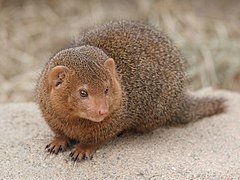Mangusteczka
| Helogale | |||
| J.E. Gray, 1862[1] | |||
 Przedstawiciel rodzaju – mangusteczka karłowata (H. parvula) | |||
| Systematyka | |||
| Domena | eukarionty | ||
|---|---|---|---|
| Królestwo | zwierzęta | ||
| Typ | strunowce | ||
| Podtyp | kręgowce | ||
| Gromada | ssaki | ||
| Podgromada | żyworodne | ||
| Infragromada | |||
| Rząd | drapieżne | ||
| Infrarząd | Viverroidea | ||
| Rodzina | mangustowate | ||
| Podrodzina | Mungotinae | ||
| Rodzaj | mangusteczka | ||
| Typ nomenklatoryczny | |||
| Herpestes parvulus Sundevall, 1847 | |||
| Gatunki | |||
| |||
| Zasięg występowania | |||
 Helogale parvula Helogale hirtula | |||
| |||
| |||
Mangusteczka (Helogale) – rodzaj ssaków z podrodziny Mungotinae w obrębie rodziny mangustowatych (Herpestidae).
Występowanie
Rodzaj obejmuje gatunki występujące w Afryce[2][3][4].
Morfologia
Długość ciała (bez ogona) 16–27 cm, długość ogona 14,2–18,3 cm, długość tylnej stopy 4,1–5,1 cm, długość ucha 1,4–2,1 cm; masa ciała 213–415 g[3][5].
Systematyka
Rodzaj zdefiniował w 1862 roku angielski zoolog John Edward Gray w artykule poświęconym nowemu rodzajowi wiwerowatych opublikowanym na łamach Proceedings of the Zoological Society of London[1]. Gray wymienił dwa gatunki – Herpestes parvulus Sundevall, 1847 i Ichneumon tænianotus A. Smith, 1834 (= Viverra mungo J.F. Gmelin, 1788) – z których gatunkiem typowym jest Herpestes parvulus Sundevall, 1847.
Etymologia
Helogale: gr. ἑλος helos ‘bagno’; γαλεή galeē lub γαλή galē ‘łasica’[6].
Podział systematyczny
Do rodzaju należą następujące występujące współcześnie gatunki[7][5][2][8][4]:
- Helogale hirtula O. Thomas, 1904 – mangusteczka etiopska
- Helogale parvula (Sundevall, 1847) – mangusteczka karłowata
Opisano również gatunki wymarłe z plejstocenu Afryki[9]:
Przypisy
- ↑ a b J.E. Gray. Notice of Helogale, a New Genus of Viverridae. „Proceedings of the Zoological Society of London”. 1861, s. 308, 1861. (ang.).
- ↑ a b C.J. Burgin, D.E. Wilson, R.A. Mittermeier, A.B. Rylands, T.E. Lacher & W. Sechrest: Illustrated Checklist of the Mammals of the World. Cz. 2: Eulipotyphla to Carnivora. Barcelona: Lynx Edicions, 2020, s. 420. ISBN 978-84-16728-35-0. (ang.).
- ↑ a b J.S. Gilchrist, A.P. Jennings, G. Veron & P. Cavallini (koordynator): Family Herpestidae (Mongooses). W: D.E. Wilson & R.A. Mittermeier (redaktorzy): Handbook of the Mammals of the World. Cz. 1: Carnivores. Barcelona: Lynx Edicions, 2009, s. 325–326. ISBN 978-84-96553-49-1. (ang.).
- ↑ a b D.E. Wilson & D.M. Reeder (redaktorzy): Helogale. [w:] Mammal Species of the World. A Taxonomic and Geographic Reference (Wyd. 3) [on-line]. Johns Hopkins University Press, 2005. [dostęp 2019-10-02].
- ↑ a b Class Mammalia. W: Lynx Nature Books: All the Mammals of the World. Barcelona: Lynx Edicions, 2023, s. 660. ISBN 978-84-16728-66-4. (ang.).
- ↑ T.S. Palmer. Index Generum Mammalium: a List of the Genera and Families of Mammals. „North American Fauna”. 23, s. 315, 1904. (ang.).
- ↑ N. Upham, C. Burgin, J. Widness, M. Becker, C. Parker, S. Liphardt, I. Rochon & D. Huckaby: Treeview of Mammalian Taxonomy Hierarchy. [w:] ASM Mammal Diversity Database (Version 1.11) [on-line]. American Society of Mammalogists. [dostęp 2023-12-16]. (ang.).
- ↑ W. Cichocki, A. Ważna, J. Cichocki, E. Rajska-Jurgiel, A. Jasiński & W. Bogdanowicz: Polskie nazewnictwo ssaków świata. Warszawa: Muzeum i Instytut Zoologii PAN, 2015, s. 144. ISBN 978-83-88147-15-9. (pol. • ang.).
- ↑ J.S.J.S. Zijlstra J.S.J.S., Helogale J.E. Gray, 1862, Hesperomys project (Version 23.8.1), DOI: 10.5281/zenodo.7654755 [dostęp 2023-12-16] (ang.).
- ↑ H.B. Wesselman: The Omo micromammals. Systematics and paleoecology of early man sites from Ethiopia. W: M.K. Hecht & F.S. Szalay (redaktorzy): Contributions to Vertebrate Evolution. Cz. 7. Basel: Karger, 1984, s. 1–219. ISBN 978-3-8055-3935-7. (ang.).
- ↑ W.O. Dietrich. Ältestquartäre Säugetiere aus der südlichen Serengeti, Deutsch-Ostafrika. „Palaeontographica”. Abteilung A. 94 (3–6), s. 43–133, 1942. (niem.).
- J9U: 987007555537205171











